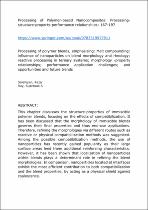 ResearchSpace
ResearchSpace
Processing of polymer blends, emphasizing: Melt compounding: influence of nanoparticles on blend morphology and rheology; reactive processing in ternary systems; morphology -property relationships; performance application challenges; and opportunities and future trends
JavaScript is disabled for your browser. Some features of this site may not work without it.
- ResearchSpace
- →
- Research Publications/Outputs
- →
- Book Chapters
- →
- View Item
| dc.contributor.author |
Salehiyan, Reza

|
|
| dc.contributor.author |
Ray, Suprakas S

|
|
| dc.date.accessioned | 2019-02-06T12:52:28Z | |
| dc.date.available | 2019-02-06T12:52:28Z | |
| dc.date.issued | 2018-10 | |
| dc.identifier.citation | Salehiyan, R. and Ray, S.S. 2018. Processing of polymer blends, emphasizing: Melt compounding: influence of nanoparticles on blend morphology and rheology; reactive processing in ternary systems; morphology -property relationships; performance application challenges; and opportunities and future trends. In: Processing of Polymer-based Nanocomposites: Processing-structure-property-performance relationships, pp. 167-197 | en_US |
| dc.identifier.isbn | 978-3-319-97792-8 | |
| dc.identifier.isbn | 978-3-319-97791-1 | |
| dc.identifier.uri | https://www.springer.com/us/book/9783319977911 | |
| dc.identifier.uri | http://hdl.handle.net/10204/10683 | |
| dc.description | Copyright: 2018 Springer. Due to copyright restrictions, the attached PDF file only contains the abstract of the full text item. For access to the full text item, please consult the publisher's website: https://www.springer.com/us/book/9783319977911 | en_US |
| dc.description.abstract | This chapter discusses the structure-properties of immiscible polymer blends, focusing on the effects of compatibilization. It has been discussed that the morphology of immiscible blends governs their final properties and thus end-use applications. Therefore, refining the morphologies via different routes such as reactive or physical compatibilization methods was suggested. Among the possible compatibilization methods, the use of nanoparticles has recently gained popularity as their large surface areas lend them additional reinforcing characteristics. However, it has been shown that localization of nanoparticles within blends plays a determinant role in refining the blend morphologies. In comparison, nanoparticles located at interfaces exhibit the most efficient contribution to both compatibilization and the blend properties, by acting as a physical shield against coalescence. | en_US |
| dc.language.iso | en | en_US |
| dc.publisher | Springer | en_US |
| dc.relation.ispartofseries | Worklist;21766 | |
| dc.subject | Inorganic Particles | en_US |
| dc.subject | Nanocomposites | en_US |
| dc.subject | Morphology | en_US |
| dc.subject | Rheology | en_US |
| dc.subject | Polymer Blends | en_US |
| dc.title | Processing of polymer blends, emphasizing: Melt compounding: influence of nanoparticles on blend morphology and rheology; reactive processing in ternary systems; morphology -property relationships; performance application challenges; and opportunities and future trends | en_US |
| dc.type | Book Chapter | en_US |
| dc.identifier.apacitation | Salehiyan, R., & Ray, S. S. (2018). Processing of polymer blends, emphasizing: Melt compounding: Influence of nanoparticles on blend morphology and rheology; reactive processing in ternary systems; morphology -Property relationships; performance application challenges; and opportunities and future trends., <i>Worklist;21766</i> Springer. http://hdl.handle.net/10204/10683 | en_ZA |
| dc.identifier.chicagocitation | Salehiyan, Reza, and Suprakas S Ray. "Processing of polymer blends, emphasizing: Melt compounding: influence of nanoparticles on blend morphology and rheology; reactive processing in ternary systems; morphology -property relationships; performance application challenges; and opportunities and future trends" In <i>WORKLIST;21766</i>, n.p.: Springer. 2018. http://hdl.handle.net/10204/10683. | en_ZA |
| dc.identifier.vancouvercitation | Salehiyan R, Ray SS. Processing of polymer blends, emphasizing: Melt compounding: influence of nanoparticles on blend morphology and rheology; reactive processing in ternary systems; morphology -property relationships; performance application challenges; and opportunities and future trends.. Worklist;21766. [place unknown]: Springer; 2018. [cited yyyy month dd]. http://hdl.handle.net/10204/10683. | en_ZA |
| dc.identifier.ris | TY - Book Chapter AU - Salehiyan, Reza AU - Ray, Suprakas S AB - This chapter discusses the structure-properties of immiscible polymer blends, focusing on the effects of compatibilization. It has been discussed that the morphology of immiscible blends governs their final properties and thus end-use applications. Therefore, refining the morphologies via different routes such as reactive or physical compatibilization methods was suggested. Among the possible compatibilization methods, the use of nanoparticles has recently gained popularity as their large surface areas lend them additional reinforcing characteristics. However, it has been shown that localization of nanoparticles within blends plays a determinant role in refining the blend morphologies. In comparison, nanoparticles located at interfaces exhibit the most efficient contribution to both compatibilization and the blend properties, by acting as a physical shield against coalescence. DA - 2018-10 DB - ResearchSpace DP - CSIR KW - Inorganic Particles KW - Nanocomposites KW - Morphology KW - Rheology KW - Polymer Blends LK - https://researchspace.csir.co.za PY - 2018 SM - 978-3-319-97792-8 SM - 978-3-319-97791-1 T1 - Processing of polymer blends, emphasizing: Melt compounding: influence of nanoparticles on blend morphology and rheology; reactive processing in ternary systems; morphology -property relationships; performance application challenges; and opportunities and future trends TI - Processing of polymer blends, emphasizing: Melt compounding: influence of nanoparticles on blend morphology and rheology; reactive processing in ternary systems; morphology -property relationships; performance application challenges; and opportunities and future trends UR - http://hdl.handle.net/10204/10683 ER - | en_ZA |





